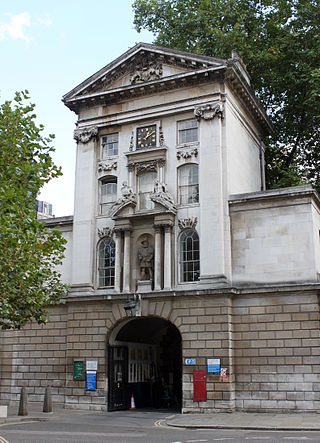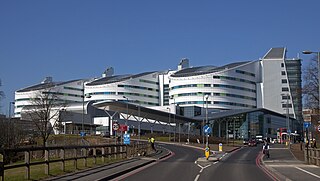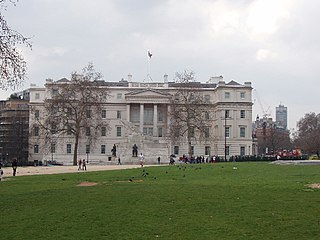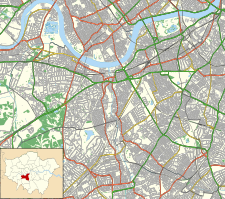
King's College Hospital is a major teaching hospital and major trauma centre in Denmark Hill, Camberwell in the London Borough of Lambeth, referred to locally and by staff simply as "King's" or abbreviated internally to "KCH". It is managed by King's College Hospital NHS Foundation Trust. It serves an inner city population of 700,000 in the London boroughs of Southwark and Lambeth, but also serves as a tertiary referral centre in certain specialties to millions of people in southern England. It is a large teaching hospital and is, with Guy's Hospital and St. Thomas' Hospital, the location of King's College London School of Medicine and one of the institutions that comprise the King's Health Partners, an academic health science centre. The chief executive is Dr Clive Kay. It is also the birthplace of Queen Camilla.

The Queen's Medical Centre is a teaching hospital situated in Nottingham, England. Until February 2012, when it was surpassed by the Royal London Hospital, it was the largest hospital in the United Kingdom, though its remains the largest major trauma centre in England. It is managed by Nottingham University Hospitals NHS Trust.

The Royal London Hospital is a large teaching hospital in Whitechapel in the London Borough of Tower Hamlets. It is part of Barts Health NHS Trust. It provides district general hospital services for the City of London and Tower Hamlets and specialist tertiary care services for patients from across London and elsewhere. The current hospital building has 845 beds and 34 wards. It opened in February 2012.

St Mary's Hospital is an NHS hospital in Paddington, in the City of Westminster, London, founded in 1845. Since the UK's first academic health science centre was created in 2008, it has been operated by Imperial College Healthcare NHS Trust, which also operates Charing Cross Hospital, Hammersmith Hospital, Queen Charlotte's and Chelsea Hospital and the Western Eye Hospital.

St Bartholomew's Hospital, commonly known as Barts, is a teaching hospital located in the City of London. It was founded in 1123 by Rahere, and is currently run by Barts Health NHS Trust.
St George's University Hospitals NHS Foundation Trust, formerly called St George's Healthcare NHS Trust, is based in Tooting in the London Borough of Wandsworth, and serves a population of 1.3 million across southwest London. A large number of services, such as cardiothoracic medicine and surgery, neurosciences and renal transplantation, also cover significant populations from Surrey and Sussex, totalling about 3.5 million people.

The Queen Elizabeth Hospital Birmingham is a major, 1,215 bed, tertiary NHS and military hospital in the Edgbaston area of Birmingham, situated very close to the University of Birmingham. The hospital, which cost £545 million to construct, opened on 16 June 2010, replacing the previous Queen Elizabeth Hospital and Selly Oak Hospital. It is one of the largest single-site hospitals in the United Kingdom and is part of one of the largest teaching trusts in England.
Professor Sir Bruce Edward Keogh, KBE, FMedSci, FRCS, FRCP is a Rhodesian-born British surgeon who specialises in cardiac surgery. He was medical director of the National Health Service in England from 2007 and national medical director of the NHS Commissioning Board from 2013 until his retirement early in 2018. He is chair of Birmingham Women's and Children's NHS Foundation Trust.

The James Cook University Hospital is a tertiary referral hospital and regional major trauma centre in Middlesbrough, North Yorkshire, England located on the A172. Having 1,046 beds, it caters for most specialities and forms part of the South Tees Hospitals NHS Foundation Trust, along with the Friarage Hospital in Northallerton.
Southampton General Hospital (SGH) is a large teaching hospital in Southampton, Hampshire, England run by University Hospital Southampton NHS Foundation Trust.

Atkinson Morley Hospital (AMH) was located at Copse Hill near Wimbledon, South-West London, England from 1869 until 2003. Initially a convalescent hospital, it became one of the most advanced brain surgery centres in the world, and was involved in the development of the CT scanner. Following its closure, neuroscience services were relocated to the new Atkinson Morley Wing of St George's Hospital, Tooting.
Hospital emergency codes are coded messages often announced over a public address system of a hospital to alert staff to various classes of on-site emergencies. The use of codes is intended to convey essential information quickly and with minimal misunderstanding to staff while preventing stress and panic among visitors to the hospital. Such codes are sometimes posted on placards throughout the hospital or are printed on employee identification badges for ready reference.

The Lanesborough is a 5-star hotel on Hyde Park Corner in Knightsbridge, central London, England. The hotel is operated by the Oetker Collection. It occupies the neoclassical former building of St George's Hospital, which is listed Grade II*. The hotel is situated next to Hyde Park Corner tube station.

Luton and Dunstable University Hospital is an acute hospital in Luton, Bedfordshire, England, run by Bedfordshire Hospitals NHS Foundation Trust. It provides medical and surgical services for over 350,000 people in southern Bedfordshire, the north of Hertfordshire and parts of Buckinghamshire. The hospital is often abbreviated to the 'L&D', and employs 3,400 staff.
University College London Hospitals NHS Foundation Trust (UCLH) is an NHS foundation trust based in London, United Kingdom. It comprises University College Hospital, University College Hospital at Westmoreland Street, the UCH Macmillan Cancer Centre, the Royal National ENT and Eastman Dental Hospitals, the Hospital for Tropical Diseases, the National Hospital for Neurology and Neurosurgery, the Royal London Hospital for Integrated Medicine and the Royal National Throat, Nose and Ear Hospital.
The Wolfson Neurorehabilitation Centre, also better known simply as The Wolfson, was a specialist neurorehabilitation centre based in Wimbledon, south west London. The services provided at the centre are now provided at St George's Hospital in Tooting and Queen Mary's Hospital in Roehampton.
North Bristol NHS Trust is a National Health Service trust that provides community healthcare and hospital services to Bristol, South Gloucestershire, and North Somerset, England. The trust employs over 8,000 staff and delivers healthcare through several medical institutions, including Southmead Hospital, Cossham Hospital, and the Bristol Centre for Enablement, as well as through various community-based clinics. In addition, medical teaching facilities are provided in association with the University of the West of England, Bristol University, and the University of Bath.
Healthcare in London, which consumes about a fifth of the NHS budget in England, is in many respects distinct from that in the rest of the United Kingdom, or England.

Sir Marriott Fawckner Nicholls CBE, FRCS, was an English surgeon who specialised in the genitourinary tract. He served in the British Army in both the First and Second World Wars and was dean of the medical school at St George's Hospital for 20 years. At the age of 64 he became professor of surgery at the University of Khartoum in Sudan, where he maintained the position until his death five years later.

The Miller General Hospital was a hospital in Greenwich, London from 1884 until 1974. It was developed adjacent to an earlier dispensary, and was the first British hospital designed with circular wards, and one of the first to have an X-ray department.

















